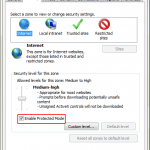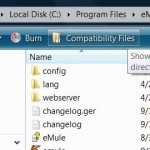Unless you turn off UAC or disable Protected Mode for IE, in Windows Vista, most of the cache, temporary files, cookies and history will be stored in special Low version location as below:
Cache: %userprofile%\AppData\Local\Microsoft\Windows\Temporary Internet Files\Low
Temp: %userprofile%\AppData\Local\Temp\Low
Cookies: %userprofile%\AppData\Roaming\Microsoft\Windows\Cookies\Low
History: %userprofile%\AppData\Local\Microsoft\Windows\History\Low
So if you’re running IE in Protected Mode, and want to access to the cache folder or other IE folders to retrieve or browse something, you have to use the following trick, because the Low version directory locations are hidden and protected by default as well.
- Open Windows Explorer.
- Click on Organize drop-down menu.
- Click on “Folder and Search Options”.
- Click on “View” tab.
- Select “Show hidden files And folders” option. You may need to double click on “Hidden files and folders” option to see these sub-options.
- Unselect (untick) “Hide protected operating system files (Recommended)” option just 2 lines below the hidden files and folders setting.
- Click OK when done.
- Navigate to the folder location where you want to browse its Low versions of contents. For example, to retrieve Internet files such as FLV flash movie, open %userprofile%\AppData\Local\Microsoft\Windows\Temporary Internet Files\Low folder.
If you cannot see the “Low” folder exists in the directory listing, click anywhere after the end of the path in Address Bar, and then append \Low to the original path, and press Enter.






